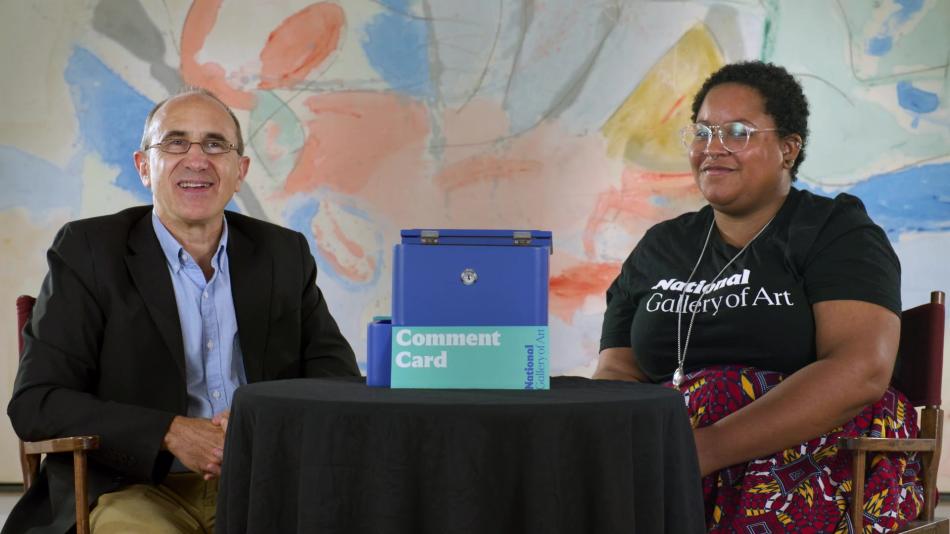Snow in New York
1902
Robert Henri
Painter, American, 1865 - 1929

Robert Henri’s energetic but stark image of New York in the snow deviates from impressionist urban snow scenes of the period in several ways: it represents a common side street rather than a major avenue; there is nothing narrative, anecdotal, or prettified about the image; the straightforward, one-point perspective composition is devoid of trivial details; the exceptionally daring, textured brushwork resembles a preparatory study rather than a finished oil painting; and the somber palette creates a dark, oppressive atmosphere. In his Record Book, Henri described Snow in New York as, “N.Y. down E. on 55th St. from 6 Ave. Brown houses at 5 Ave. storm effect. snow. wagon to right.”
Having returned to New York City in 1900 following an extended stay in Paris, Henri eventually established a studio and living quarters in the Sherwood Building on the corner of West 57th Street and Sixth Avenue. In March 1902 the dealer William Macbeth encouraged him to paint New York cityscapes for inclusion in a solo exhibition scheduled for the following month. Henri hoped to produce a painting for the occasion that would achieve a degree of critical acclaim comparable to that of La Neige (1899, Louvre, Paris), a snowy view of the rue de Sèvres in Paris that had been purchased for the Musée du Luxembourg in 1899. While a buyer was found for Snow in New York, only one other work sold, prompting Henri to turn his attention primarily to portraiture.
Artwork overview
-
Medium
oil on canvas
-
Credit Line
-
Dimensions
overall: 81.3 x 65.5 cm (32 x 25 13/16 in.)
framed: 105.4 x 89.2 x 10.1 cm (41 1/2 x 35 1/8 x 4 in.) -
Accession Number
1954.4.3
More About this Artwork

Video: Is Pablo Picasso Overrated?
The National Gallery’s own Harry Cooper and LaStarsha McGarity declare Picasso overrated and question if Chet Hanks is indeed the greatest artist of all time on our fifth episode of Ask the National Gallery Anything.
Artwork history & notes
Provenance
Sold 1902 to A.J. Crawford.[1] (Sale, James P. Silo, New York, 20-21 February 1925, no. 268); Chester Dale [1883-1962], New York; gift 1954 to NGA.
[1] The painting was possibly sold out of the 1902 exibition of Henri's work at Macbeth Gallery in New York. The sale date and reference to Crawford are in the artist's journal, as follows: "Sold to A.J. (?) Crawford (Annex Little Shop) 253 5th Ave.1902. In Mr. Crawford's house in London England 1906." The transcription of the journal entry was provided by Chapellier Galleries, New York, in a letter of 28 June 1968 to NGA curator E. John Bullard III; in NGA curatorial files.
Associated Names
Exhibition History
1902
Exhibition of Pictures by Robert Henri, Macbeth Gallery, New York, 1902, no. 6.
1937
An Exhibition of American Paintings from the Chester Dale Collection, The Union League Club, New York, 1937, no. 45, as New York Street in Winter.
New York Realists 1900-1914, Whitney Museum of American Art, New York, 1937, no. 26, as New York Street in Winter.
1943
Paintings from the Chester Dale Collection, Philadelphia Museum of Art, 1943-1951, unnumbered catalogue, repro., as New York Street in Winter.
1965
The Chester Dale Bequest, National Gallery of Art, Washington, D.C., 1965, unnumbered checklist, as New York Street in Winter.
2010
From Impressionism to Modernism: The Chester Dale Collection, National Gallery of Art, Washington, January 2010-January 2012, unnumbered catalogue, repro.
Bibliography
1943
Paintings from the Chester Dale Collection. Philadelphia, 1943: unpaginated, repro.
1951
Walker, John. Paintings from America. Harmondsworth, England, 1951: 36, 43, pl. 43, as New York Street in Winter.
1965
Paintings other than French in the Chester Dale Collection. National Gallery of Art, Washington, 1965: 47, repro., color repro. as frontispiece, as New York Street in Winter.
1970
American Paintings and Sculpture: An Illustrated Catalogue. National Gallery of Art, Washington, 1970: 66, repro.
1973
Young, Mahonri Sharp. The Eight. New York, 1973: 24, repro.
1980
Wilmerding, John. American Masterpieces from the National Gallery of Art. National Gallery of Art, Washington, D.C., 1980: 134, repro.
American Paintings: An Illustrated Catalogue. National Gallery of Art, Washington, 1980: 174, repro.
1981
Williams, William James. A Heritage of American Paintings from the National Gallery of Art. New York, 1981: color repro. 167, 199, 201.
1983
Brown, Milton W. One Hundred Masterpieces of American Painting from Public Collections in Washington, D.C. Washington, D.C., 1983: 124-125, color pl.
1984
Walker, John. National Gallery of Art, Washington. Rev. ed. New York, 1984: 572, no. 875, color repro.
1986
Chambers, Bruce. “Robert Henri’s Street Scene with Snow (57th Street, N.Y.C.): An Ideal of City ‘in Snow Effect.’” Yale University Art Gallery Bulletin 39 (Winter 1986): 30-39; 37-38, fig. 7.
1988
Wilmerding, John. American Masterpieces from the National Gallery of Art. Rev. ed. National Gallery of Art, Washington, D.C., 1988: 154, repro.
1991
Perlman, Bennard B. Robert Henri: His Life and Art. New York, 1991: 55-56.
1992
American Paintings: An Illustrated Catalogue. National Gallery of Art, Washington, 1992: 199, repro.
1994
Gerdts, William H. Impressionist New York. New York, 1994: 35, pl. 22.
1995
Zurier, Rebecca, Robert W. Snyder, and Virginia M. Mecklenburg. Metropolitan Lives: The Ashcan Artists and Their New York. Exh. cat. National Museum of American Art, Washington, D.C., 1995: 69-70, fig. 68.
1997
Southgate, M. Therese. The Art of JAMA: One Hundred Covers and Essays from The Journal of the American Medical Association. St. Louis, 1997: 62, 202, color repro.
Inscriptions
lower left: Robert Henri / Mar 5 1902
Wikidata ID
Q15705359



